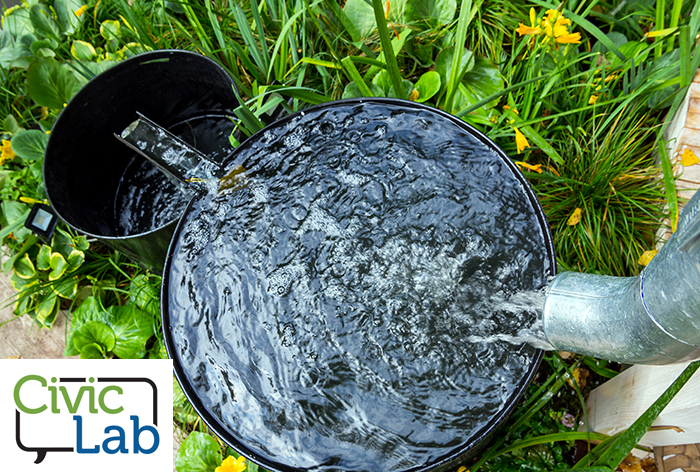Civic Lab Online: Water Conservation & Gardening
Posted on April 1, 2021 at 6:00 am

About Civic Lab Online
Civic Lab Online provides information on issues facing our community for you to explore. Take a look at thought-provoking materials for teens and adults that allow us to engage in open conversation and grow together as a community. You’ll find all past topics on the Civic Lab Online web page.
Water Conservation & Gardening
While many major factors affect our environment, small home gardens have an important place in our ecology. In this Civic Lab Online, we provide some tips for gardeners to increase their green thumbprint while gardening, some ways to reduce the amount of water used for yards, a DIY guide for creating your own rain barrel, and more ideas to increase water conservation efforts in your home and yard.

Fast Facts
According to the Fourth National Climate Assessment, a federally mandated report that is delivered to the U.S. Congress every four years (https://nca2018.globalchange.gov/):
“Rising air and water temperatures and changes in precipitation are intensifying droughts, increasing heavy downpours, reducing snowpack, and causing declines in surface water quality, with varying impacts across regions. Future warming will add to the stress on water supplies and adversely impact the availability of water in parts of the United States.”
While many major factors affect our environment, small home gardens also have an important place in our ecology. Below are some tips for gardeners to increase their green thumbprint while gardening, and a DIY guide for creating your own water barrel to increase water conservation efforts in your home and yard.
More about Water Conservation & Gardening
- Why Gardeners Care ): Higher average temperatures and shifting precipitation patterns are causing plants to bloom earlier, creating unpredictable growing seasons.
- The maps showing the “Shifts in U.S. planting zones between 1971-2000 and 1981-2010” (https://noaa.maps.arcgis.com/apps/MapSeries/index.html?appid=5f617f338eb5431eb3700e8685eccaf7) can help you see how planting zones where you live may have shifted over the past few decades in response to the warming climate.
- Invasive, non-native plants’ and animals’ ranges are expanding and making them more apt to take advantage of weakened ecosystems and outcompete native species. Some of the most problematic species, including kudzu, garlic mustard, and purple loosestrife, may thrive under new conditions and move into new areas.
- Important connections between pollinators, breeding birds, insects, and other wildlife and the plants they depend on will be disrupted with habitat loss, disease, and pesticides. Pollinators such as hummingbirds and bees may arrive either too early or too late to feed on the flowers on which they normally rely. We can all aid in the recovery of these species. To find out ways you can help, the National Wildlife Federation provided tips on their Pollinator Recovery webpage (https://www.nwf.org/Garden-for-Wildlife/About/National-Initiatives/Pollinators).
Tips for Saving Water in Your Backyard & Community
- Improving your energy efficiency (https://www.nwf.org/Get-Involved/Live-Green/Energy-Conservation): Using energy-efficient products and reducing your household’s energy consumption will reduce your contribution to carbon pollution. In your front and back yards, you can replace outdoor light bulbs with high-efficiency LED bulbs, install outdoor automatic light timers, or purchase solar-powered garden products.
- Reducing the use of gasoline-powered yard tools (https://www.nwf.org/Get-Involved/Live-Green/Energy-Conservation): You can avoid using gasoline-powered tools such as lawn mowers and leaf blowers. Instead, you can use human-powered tools such as push mowers, hand clippers, and rakes, or you can reduce the amount of lawn area that needs maintenance. Using a gasoline-powered mower for an hour pollutes 10 to 12 times more than the average automobile.
- Reducing invasive species expansion and incorporating diverse native species (https://www.nwf.org/Garden-for-Wildlife/About/Native-Plants): Native plants help to maintain important pollinator connections and ensure food sources for wildlife. Non-native plants can outcompete these important native species for habitat and food. Removing invasive plants from your garden and choosing an array of native alternatives can minimize the threat of invasive species expansion. You can also contact your local or state native plant society to find out what plants are native to your area.
- Reducing water consumption (https://www.nwf.org/Get-Involved/Live-Green/Water-Conservation): There are a number of ways to reduce water consumption in your garden, which is particularly important during increased heat waves and droughts. These ways include mulching, installing rain barrels, adjusting your watering schedule, and using drip irrigation. Practices like mulching also provide nutrients to the soil, reducing the need for chemical fertilizers, which take significant amounts of energy to produce.
- Composting kitchen and garden waste (https://www.nwf.org/Garden-for-Wildlife/Sustainability/Soil-Water-Conservation/Worm-Compost-Bin): Composting this waste can significantly reduce your contribution to carbon pollution, especially methane, a highly potent greenhouse gas. Composting also provides an excellent source of nutrients for your garden, reducing the need for chemical fertilizers.
- Planting trees to absorb carbon dioxide (https://www.nwf.org/Trees-for-Wildlife/About/Trees-Make-a-Difference): Trees can absorb and store as much as a ton of carbon pollution (CO2) from the atmosphere. If every one of America’s 85 million gardening households planted just one young shade tree in their yard or community, those trees would absorb more than 2 million tons of CO2 each year. Shade trees planted near your home can also reduce energy used for cooling in the summer.
Rain Barrel Resource Guide
Using a rain barrel to harvest water is a productive way to conserve water and reduce run-off that can pollute the rivers and aquifer. The City of Spokane provides a guide to create your own rain barrel: https://static.spokanecity.org/documents/publicworks/water/rain-barrel-guide.pdf
Read, Watch, Listen

READ
Bainbridge, D. A. (2016). Gardening with Less Water: Low-Tech, Low-Cost Techniques for Using up to 90% Less Water in Your Garden. Pownal, MA: Storey.
Are you facing drought or water shortages? Gardening with Less Water offers simple, inexpensive, low-tech techniques for watering your garden much more efficiently—using up to 90% less water for the same results. With illustrated step-by-step instructions, David Bainbridge shows you how to install buried clay pots and pipes, wicking systems, and other porous containers that deliver water directly to a plant’s roots with no or minimal evaporation. These systems are available at hardware stores and garden centers; are easy to set up and use; and work for garden beds, container gardens, and trees.
Penick, P. (2016). The Water-Saving Garden. Berkeley, CA: Ten Speed Press.
The Water-Saving Garden provides gardeners and homeowners with a diverse array of techniques and inspiration for creating outdoor spaces that are so beautiful and inviting, it’s hard to believe they are water-thrifty. Including a directory of 100 plants appropriate for a variety of drought-prone regions of the country, this accessible and contemporary guide is full of must-know information on popular gardening topics like native and drought-tolerant plants, rainwater harvesting, greywater systems, permeable paving, and more.
Kruckeberg, Arthur R. and Chalker-Scott, Linda (2019).Gardening with Native Plants of the Pacific Northwest. Seattle, WA. University of Washington Press.
The Pacific Northwest abounds with native plants that bring beauty to the home garden while offering food and shelter to birds, bees, butterflies, and other wildlife.

WATCH
The Great Courses: The Science of Gardening. Professor Linda Chalker-Scott. Chantilly, VA.: The Teaching Company, 2018. DVD. https://catalog.scld.org/redirect
When scientists examine home gardens and landscapes, one fact stands out: The leading cause of landscape failure is not disease and it’s not pests—it’s our own gardening practices. The Science of Gardening will help you create a beautiful and sustainable home garden guided by the newest information from applied plant physiology, biology, soils science, climatology, hydrology, chemistry, and ecology. From choosing and purchasing your trees and shrubs, to giving them the best start in your garden, to healthy maintenance and pest control, award-winning horticulturist Linda Chalker-Scott of Washington State University shows why science-based decisions are always best for your home garden and also the most ecologically sound for the greater environment. (Review from Amazon.com)

LISTEN
“Earth Week – Water Wise Spokane”. Spokane City, 27 April 2020. https://vimeo.com/412520424
Take a tour of the Spokane water system from the ground up, and get a closer look at how we use water. This video goes over some simple water saving ideas.
Additional information
Lawn care can use up a lot of water. Below are tips provided by the City of Spokane on how to use water for your lawn and garden, including sprinkler use. In Spokane, residential consumers currently use the most water. Our region is categorized as “high desert,” which is why many people use so much water to keep the grass green.
QUICK TIPS
(Source: https://my.spokanecity.org/publicworks/water/water-wise-spokane/outdoor-conservation/)
Timing is everything
- Water your lawn or garden during the cool early morning hours, as opposed to midday, to reduce evaporation.
- Use an automatic timer on your sprinkler or set a kitchen timer to remind you to turn off the water. When left unattended, a garden hose can waste as much as 600 gallons of water in just one hour!
Let it grow
- Raise your lawn mower blade to at least 3 inches. Taller grass promotes deeper roots, shades the root system, and holds soil moisture better than a closely cropped lawn.
- Don’t over fertilize. You will increase the lawn’s need for water.
Tune up your system
- Inspect irrigation systems and fix leaks and broken or clogged sprinkler heads. A broken sprinkler can waste 25,000 gallons in 6 months!
- Make sure you’re watering the yard and not the street or driveway.
Water when needed
- Lawns only need watering every 3 to 5 days in the summer. Watering more than 1 inch per week means you’re just watering the ground below.
- Look for sprinklers that produce droplets or use a soaker hose to water trees and shrubs.
SPRINKLERS
How much is enough?
One of the easiest ways to save water is to make sure that you are not overwatering your lawn and plants. Most of us water more than needed, which not only wastes water but also drowns our plants.
- According to numerous studies, a healthy lawn needs only about 1 inch of rain per week. When using a sprinkler system or hose, that’s the equivalent of 60 gallons per 100 square feet.
- Watering a garden is a little more complicated because the amount of moisture needed by vegetables, fruits, and flowers varies, and these plants are more sensitive to heat. The “one-inch-per-week” guideline generally applies with a few modifications.
- When the weather is hot, it is recommended that a half inch of water is added per week for every 10 degrees that the average daily temperature exceeds 60 degrees. Always water your lawn or garden during the cool morning hours, as opposed to midday, to reduce evaporation.
- Soil type is also a factor when determining the amount of water your lawn and garden need. Since sandy soils drain faster, they require more water than other soil types. In most cases, a deep watering twice per week is sufficient once the plants are established. If the soil is moist at a depth of 6 inches, this is ideal.
- A rain sensor for an automatic irrigation system will allow your system to automatically shut-off if rainfall exceeds a certain amount. Afterward, the system will automatically resume its normal schedule.
ADDITIONAL RESOURCES
- Drought Tolerant Plants – WSU Extension (PDF)
- EPA – Residential Water Efficiency (PDF)
- Irrigation Controllers (PDF)
- Smart Watering (PDF)
- Using Water Wisely (PDF)
- Spokane SmartScape
- EPA: Use Your Water Sense
- Ecology: Water Conservation
- Spokane Aquifer Joint Board Conservation
- HomeAdvisor Water Conservation Throughout the Home
Digital Resources

Hobbies & Crafts Resource Center
Access the gardening section within this resource at www.scld.org/hobbies-crafts-gardening
Print & Other Materials in Our Catalog
Search our catalog for books, large print, eBooks, and audiobooks at www.scld.org/catalog.
Downloadable Documents
Fast Facts: Water Conservation & Gardening
Read, Watch, Listen: Water Conservation & Gardening
Additional Information: Water Conservation & Gardening
Tags: adults, civic lab, community, Discussion, gardening, rain barrels, teens, tips, water conservation
